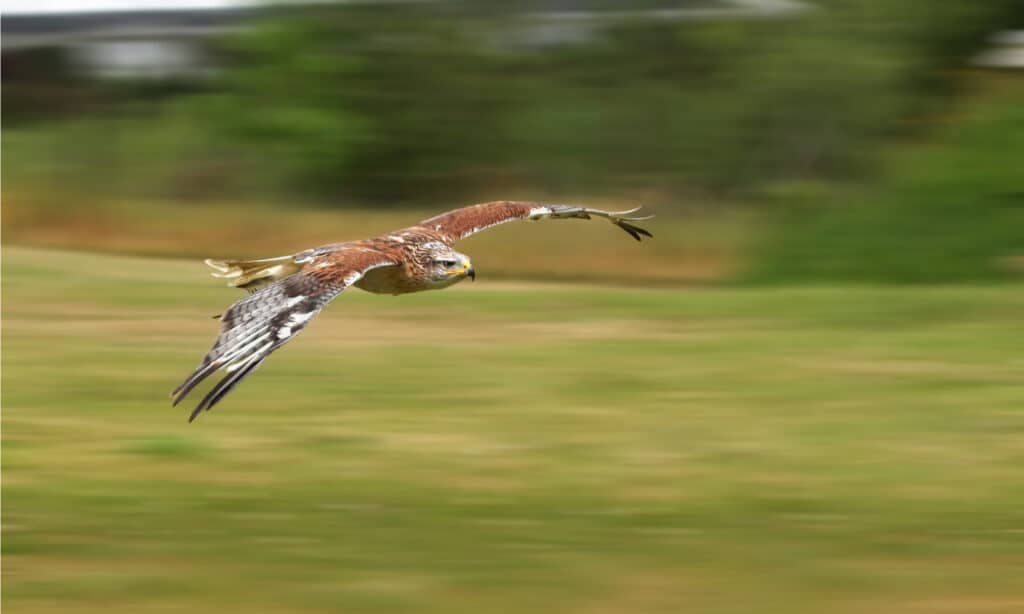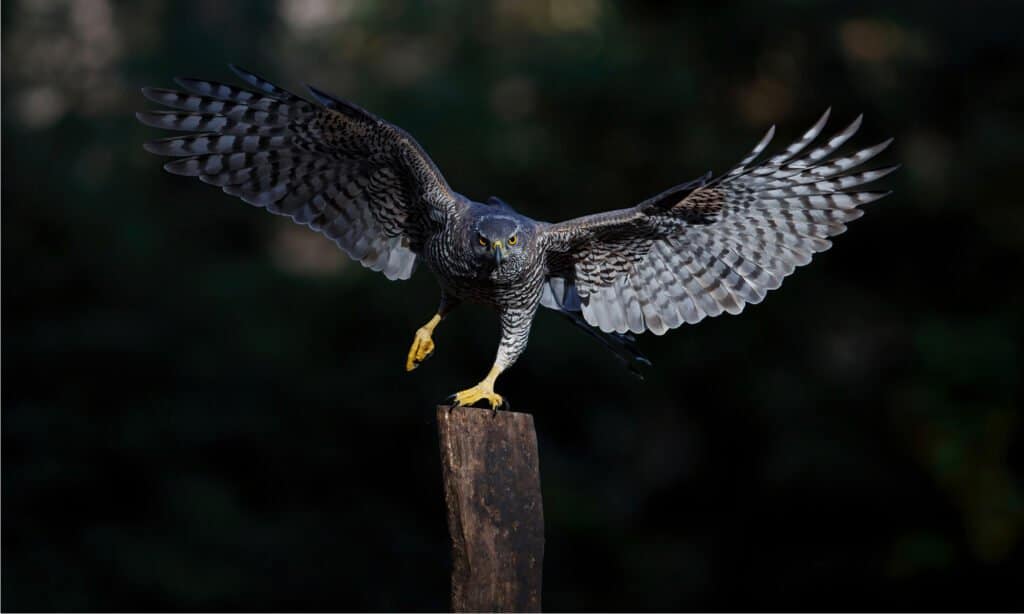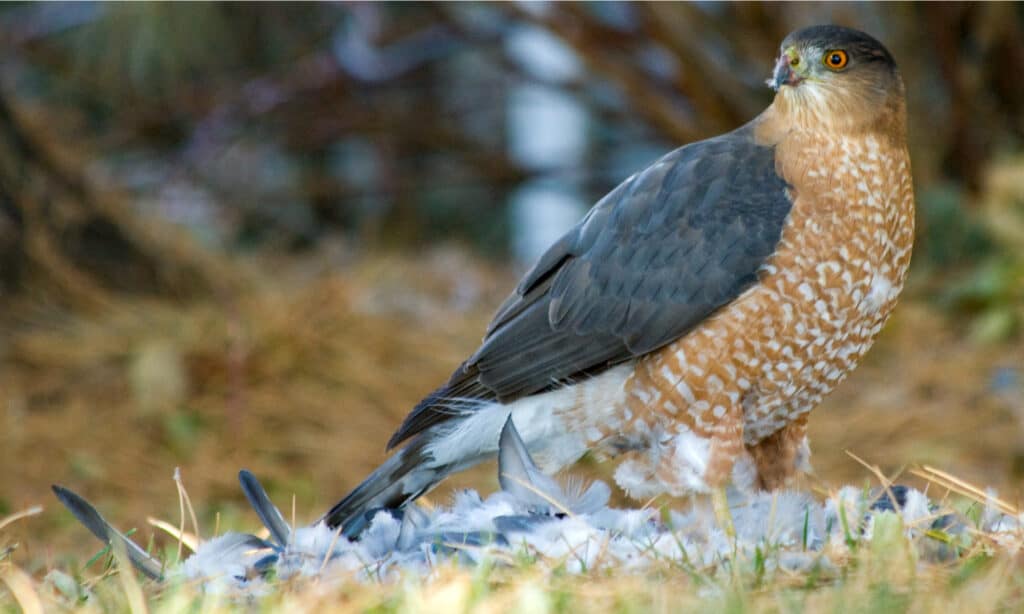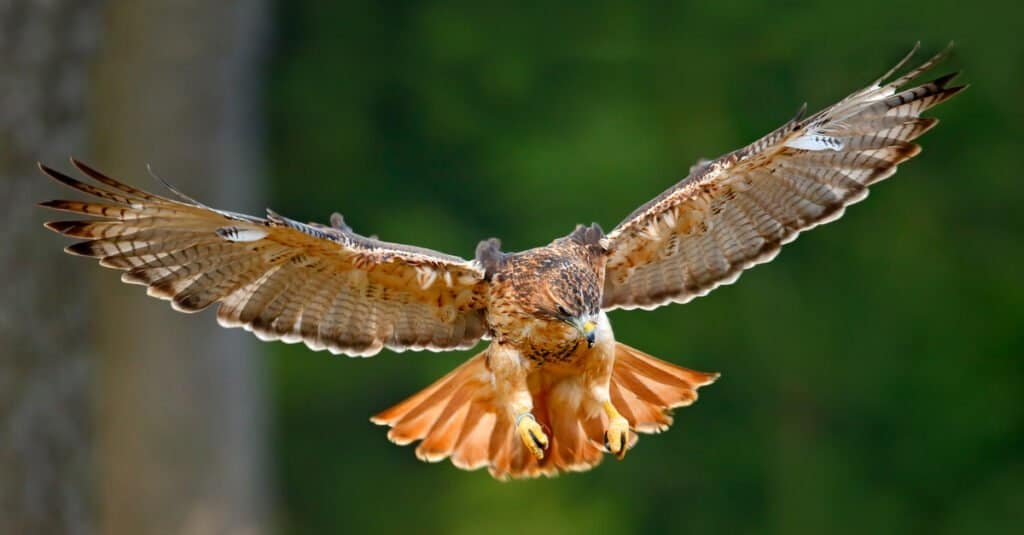Indiana boasts a wide range of ecosystems, including forests, wetlands, and aquatic ecosystems, that provide habitats for numerous birds and mammals. Approximately 413 species of birds live within the state. More than 260 species occasionally visit the state each year.
The Hoosier state is home to some of the most famous species of hawks in the country. Indiana has an extensive series of birding sites throughout the entire state. Experience some of the most exciting fall migration by visiting Indiana between September and November.
Let’s have a look at the 8 types of hawks you’re most likely to come across while exploring some Indiana birding hotspots.
1. Broad-winged Hawk

Broad-winged hawks build their nests in deciduous forests or mixed coniferous-deciduous forests.
©pr2is/Shutterstock.com
| Broad-winged Hawk | |
|---|---|
| Scientific name | Buteo platypterus |
| Weight | 9-20 oz |
| Height | 13-17 in |
| Wingspan | 32-39 in |
Broad-winged hawks are small raptors that are occasionally found in Indiana, more commonly in the south of the state. The migration in the fall offers the best chance to see them. They are dark brown on top and white underneath. These raptors inhabit the woods and groves.
Their diet consists mainly of squirrels, voles, toads, frogs, young turtles, lizards, snakes, and various small birds, but sometimes they eat earthworms, centipedes, and crayfish. They hunt by watching for prey from a perch and then swoop rapidly to catch it once they spot one.
Broad-winged hawks build their nests in deciduous forests or mixed coniferous-deciduous forests. They often prefer clearings, edges, or water bodies. Both sexes build the nests. Females lay 2-3 whitish eggs, which take about 28-31 days to hatch.
2. Rough-legged Hawk

Rough-legged hawks mainly feed on rodents, small birds, frogs, and insects.
©Eivor Kuchta/Shutterstock.com
| Rough-legged Hawk | |
|---|---|
| Scientific name | Buteo lagopus |
| Weight | 1.32-3.66 lbs |
| Height | 18–24 in (46–60 cm) |
| Wingspan | 52-54 in (132-138 cm) |
Rough-legged hawks are commonly sighted in Indiana during winter. They spend most of their time in open fields, including marshes, coastal prairies, dunes, and farmlands. They are dark brown with black-banded tails.
Rough-legged hawks mainly feed on rodents, small birds, frogs, and insects. Their diet consists of carrion during winter. These raptors are often seen hovering over fields to catch sight of prey movement below. They may also choose to watch for prey from a perch.
These hawks breed mainly on the tundra, in areas having narrow ledges and high cliffs for nest sites. Others even nest on level ground or at the edges of a forest, usually on top of a tree. Females lay between 3 and 5 eggs, which take roughly 31 days to hatch.
3. Red-shouldered Hawk

Red-shouldered hawks inhabit wooded streamsides, bottomland woods, and swampy areas.
©MTKhaled mahmud/Shutterstock.com
| Red-shouldered Hawk | |
|---|---|
| Scientific name | Buteo lineatus |
| Weight | 1-1.7 lbs (486-774g) |
| Height | 15-24 in (38-61 cm) |
| Wingspan | 35-50 in (90-127 cm) |
Red-shouldered hawks can be found in Indiana throughout the year. They inhabit wooded streamsides, bottomland woods, and swampy areas. These hawks have very distinctive white-and-black checkered wings.
Their diet consists of chipmunks, voles, squirrels, snakes, toads, frogs, and numerous small birds. Like broad-winged hawks, red-shouldered hawks also hunt by watching for prey from a perch. Sometimes they may opt to fly low over open fields, taking prey by surprise.
Red-shouldered hawks nest in deciduous or mixed forests, usually at the base of the branches against the trunk. Both sexes participate in building the nests, which are reused for more than one season. Females lay 3-4 white or pale-bluish eggs.
4. Northern Harrier

Northern harriers often nest in marshes or dry open fields.
©Harry Collins Photography/Shutterstock.com
| Northern Harrier | |
|---|---|
| Scientific name | Circus hudsonius |
| Weight | 11-27 oz (300-750 g) |
| Height | 21-25 in (53-64cm) |
| Wingspan | 41-46 in (103-117 cm) |
Northern harriers are commonly sighted in Indiana during winter. They live on the prairies, fields, and marshes. They inhabit any kind of open terrain- both wet and dry- as long as there is good ground cover. Males are gray on top and white below. Females are brown on top with whitish undersides.
Their diet consists of voles, lizards, snakes, toads, frogs, small rabbits, and small birds. They are usually spotted flying low over fields, scanning for prey movement. They can also hover over dense cover in an attempt to drive out prey.
Northern harriers often nest in marshes or dry open fields. Females build the nests while males supply the nesting materials. Females lay 4-6 pale-bluish eggs, which take about 30-32 days to hatch.
5. Northern Goshawk

Northern goshawks usually perch silently on mid-level trees and prefer to surprise unsuspecting prey.
©Henk Bogaard/Shutterstock.com
| Northern Goshawk | |
|---|---|
| Scientific name | Accipiter gentilis |
| Weight | 1.4-4.8 lbs |
| Height | 18-27 in (46-69 cm) |
| Wingspan | 40-46 in (103-117 cm) |
Northern goshawks can be found in Indiana all year. They inhabit coniferous or mixed forests. Typically, these hawks are restricted to wooded areas but may be sighted along the edges or in open woods. They are dark slate gray on top with pale-gray barred underneath.
Their diet consists of most small mammals and birds. They feed on snowshoe hares, grouse, crows, snakes, insects, squirrels, and rabbits. They usually perch silently on mid-level trees and prefer to surprise unsuspecting prey.
Breeding often takes place in mixed woods. Females are in charge of building nests that are reused each year. They only add more materials. Hence, they become quite large. Females lay 2-4 bluish-white eggs. The incubation period lasts about 32-38 days, and females often do it.
6. Cooper’s Hawk

Cooper’s hawks mainly feed on birds and small mammals.
©Richard G Smith/Shutterstock.com
| Cooper’s Hawk | |
|---|---|
| Scientific name | Accipiter cooperii |
| Weight | 8-15 oz (220-410 g) |
| Height | 14-20 in (35-50 cm) |
| Wingspan | 24-39 in (62-99 cm) |
Cooper’s hawks are commonly sighted in Indiana all year. They mainly inhabit open woodlands, mature forests, river groves, and wood edges. They look very similar to sharp-shinned hawks but much bigger. They are grayish-blue above with reddish bars underneath.
Cooper’s hawks mainly feed on birds and small mammals. They usually hunt these animals by moving from one perch to the other. They put on a burst of speed to overtake the prey once they spot one.
Cooper’s hawks build their nests on top of deciduous or coniferous trees. They often prefer improving an already pre-existing foundation like a squirrel’s nest rather than building their nests afresh. Females lay between 3 and 5 pale bluish-white eggs.
7. Sharp-shinned Hawk

Sharp-shinned hawks can be spotted in open deciduous woodlands, mixed or coniferous forests, and edges.
©Wyatt W/Shutterstock.com
| Sharp-shinned Hawk | |
|---|---|
| Scientific name | Accipiter striatus |
| Weight | 2.9-7.7 oz (82-219 g) |
| Height | 9.1-15 in (23-37 cm) |
| Wingspan | 17-27 in (42-68 cm) |
Sharp-shinned hawks can be found all year in Indiana, although they are highly migratory birds of prey. They can be spotted in open deciduous woodlands, mixed or coniferous forests, and edges. They are the smallest hawks found within the state and are slaty blue-gray on top with red-orange bars on the breasts.
Sharp-shinned hawks feed on small birds and a small number of rodents, snakes, frogs, toads, large insects, and lizards. They usually perch on dense or shallow vegetation and wait for prey to approach.
These raptors breed in groves of pure coniferous and dense deciduous trees. Both sexes supply the nesting materials, but females do most of the construction. Females lay between 4-5 bluish-white eggs, which take around 30-35 days to hatch.
8. Red-tailed Hawk

Red-tailed hawks hunt by watching for prey from a perch, then swoop down rapidly to capture the prey using their sharp talons.
©Ondrej Prosicky/Shutterstock.com
| Red-tailed Hawk | |
|---|---|
| Scientific name | Buteo jamaicensis |
| Weight | 1.5-3.5 lbs |
| Height | 18-26 in (45-65 cm) |
| Wingspan | 43-56 in (110-141 cm) |
Red-tailed hawks are common in Indiana. They inhabit the mountains, prairie groves, woodlands, and open fields. You are most likely to run into them while on a long car journey. They are named after their distinctive red tails. They are rich brown on top and pale on their underneath with a streaked belly.
Their diet consists of small mammals, birds, and reptiles. Ground squirrels, rats, rabbits, and voles are often their major prey. They hunt by watching for prey from a perch, then swoop down rapidly to capture the prey using their sharp talons.
Red-tailed hawks build nests in a variety of habitats. They may choose to nest on some of the tallest trees in a particular area, on cliff ledges, on some of the artificial structures like buildings, or among the arms of giant cacti. Females lay between 2-3 eggs that are blotched with brown. The incubation period lasts for 28-35 days, and both parents do it.
The photo featured at the top of this post is © MTKhaled mahmud/Shutterstock.com
Thank you for reading! Have some feedback for us? Contact the AZ Animals editorial team.







